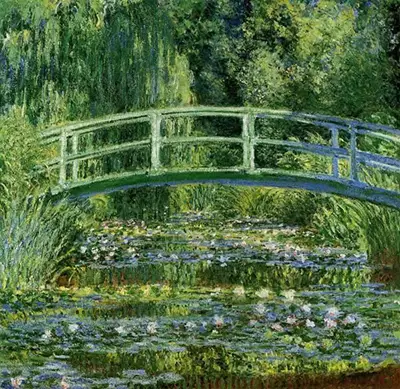This version appears very similar to The Water Lily Pond but with a different balance in the colours. The term Green Harmony refers to the increased balance of green tones within this painting. All others, such as white, blue and pink are all relatively subdued here as Monet continues to experiment. Everything else is consistent with a number of other of his paintings, with the bridge stretching across the canvas, spread over the water lily pond that comes through underneath. Behind are the same trees, which block out any view of the sky behind. In this example the light appears from the left, draped over the hand rails and also impacting some of the water below. In other cases he would avoid any shadowing on the bridge, or alternatively redirect the light to come from a different angle.
Monet was a keen gardener and already had an existing flower garden prior to purchasing land. It was order to try to put together another one which was to use water as a main feature within it. The results have become some of the most recognisable images in western art, and he also used this location as a means to study and document the changing impact of light and colour across the day, as well as in different seasons. Whilst travelling regularly throughout his life in order to understand and experience new surroundings as much as possible, he was never happier than when at home in his own garden, and here he would produce hundreds of paintings from different angles and view points within his own version of heaven. The garden still exists today and is well cared for as a tribute to his life and career. He would also produce a related artwork called Waterlily Pond, Harmony in Pink, which concentrated on tones of pink instead.
The painting itself is dated at 1899, a year in which he worked tirelessly within his garden and produced a large amount of work. The piece is believed to be in the collection of the Musée d'Orsay, Paris, thanks to a generous bequeth from Count Isaac de Camondo in 1911. Visitors here will be able to enjoy an extraordinary collection of French art, with nearly one hundred paintings from Monet to be found here alone. Déjeuner sur l'herbe, Haystacks, The Magpie and Women in the Garden are all here, for example, as well as a number of other contributions to his series on his Japanese Bridge and the Water Lily pond of his Giverny garden. The institution remains one of the finest establishments for learning and enjoying French art, perhaps only out done by the Louvre in that regard.


